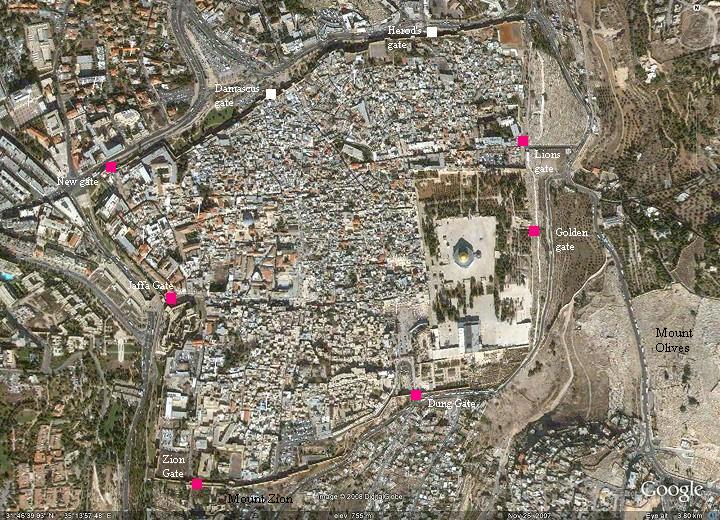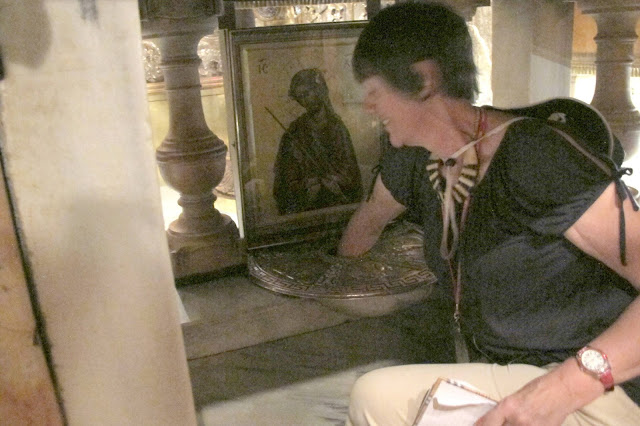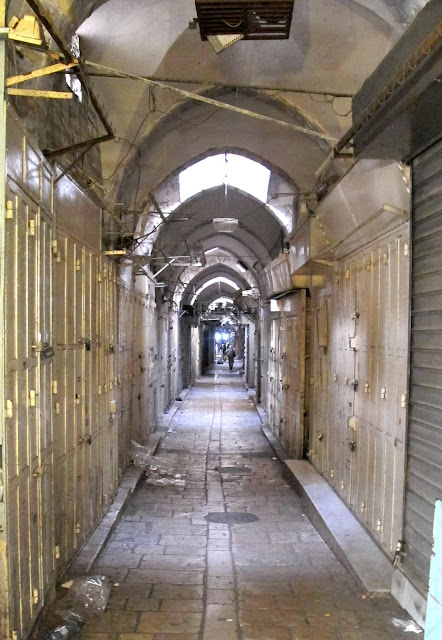SHABAT SHALOM
"may your day of no work be peaceful"
 |
We started our day in the bus with a prayer and sang "Amen, Amen" Didn't get past "Amen".
All around us people were getting ready for the Sabbath.
Orthodox Jewish and some Muslim streets were blocked off, men were getting ready for their ritual baths. Clothing was different and various head coverings were seen, and it was much quieter on the streets. |
 |
| East side of Mount Zion |
 |
| Steps going down into one room of a home. |
 |
| Original 1st century pavement. Broken pillars that held up the roof. |
 |
| Where Jesus walked. |
 |
| South end of the Wailing Wall/Western Wall. |
 |
| "We are Pilgrims on a Journey....When we sing to God in Heaven we shall find such harmony, born of all we've known together of Christ's love and agony." |
 |
Southern Steps
The western flight of stairs leading to the main entrances of the Temple Mount was 200 feet wide. Excavators uncovered the easternmost part of this staircase with its alternating long and short steps. Some suggest that the fifteen long steps may have been one of the locations where pilgrims sang the fifteen Psalms of Ascent (120-34) as they went up to worship.
|
 |
| Original stairs at the exit of the temple. |
 |
Double Gate
The Double Gates and Triple Gates provided access to the Temple Mount through subterranean passageways. Half of the lintel stone and relieving arch of this Herodian gateway is visible above the later protruding arch. Above and to the right is a stone with an inscription mentioning Hadrian's son (AD 138). Its position upside down clearly indicates that it is in secondary use.
|
 |
| After 3 days in the temple, Jesus was sitting on these steps. |
 |
Trumpeting Stone
The top stone on the southwest corner of the Temple Mount bore an inscription which read in part, "to the place of trumpeting." The priests would signal the start of Shabbat and festival days by blowing the shofar from this point. The inscription was apparently only a notice to the construction workers as to the final destination of this specially-cut stone.
|
 |
This street was fully uncovered in the mid-1990s and dates to the decades before the city's destruction by the Romans in AD 70. The street is 32 feet (10 m) wide and was paved with large slabs up to a foot thick. The street (1 km long) was covered with massive stones pushed down by the Romans; only part of the street has been cleared by the excavators. It had two large drainage channels running beneath it, and shops opened on to the street onto both sides.
|
 |
Mikveh
A series of public ritual bathing installations were found on the south side of the Temple Mount. Because of the demanding laws regarding purity before entering holy places, demand for mikveh was high and many have been discovered from first century Jerusalem. Larger ritual baths such as this one have a small divider wall separating the entrance route from the exit.
|
 |
I asked these armed guards if I could take their pictures and they said "yes".
The guard on the right even stood up for me. |
 |
| Windmill built by the Spanish. Jaffa Gate Mill |
 |
| Doesn't say how much Hebrew!! |
 |
| Carob tree. Black pods. |
Next we went to the YAT VASHEM (You cannot exist) Holocaust History Museum.
Marcel and I decided not to go in.
We had lunch here and the restaurant was divided into two sections. Dairy and Meat.
 |
We took the bus to the Jaffa Gate of the old city of Jerusalem.
Doron gave us some free time to shop.
Wall to wall people everywhere. |
 |
| After getting thoroughly lost in the maze, we asked a shopkeeper where the gate was. He said "which one, there are nine gates". He directed us to the Jaffa gate. |
 |
No wonder we got lost. If we hadn't asked for directions,
we would still be wandering in here and be adorned with jewellery and scarves from top to toe. |
 |
| We found our way out and decided on a bagel for lunch at the Jaffa Gate. |
 |
| Refreshing orange and pomegranate drink. |
 |
Waiting for the rest of the group to finish shopping.
Jon, Marcel, Nicole and Erik. |
 |
| And...We...Walk |
 |
| Church of the Holy Sepulcher or Church of the Resurrection |
 |
| The Rock of Calvary (12th Station of the Cross). The rock can be seen under glass on both sides of the altar, and beneath the altar there is a hole said to be the place where the cross was raised. Original stone, 23 feet lifted up, all else was built on. |
 |
| The Greek Orthodox crucifixion altar places the exact site of the crucifixion. A silver disk with a central hole, underneath the altar, marks the spot on the rock where the cross stood. |
 |
On the floor near the entrance: The Stone of Unction, also known as the Stone of Anointing, is the place where Christ’ body was laid down after being removed from the crucifix and prepared for burial.
He was anointed and wrapped in shrouds as the Jews
customarily prepared their dead for burial at the time. |
 |
| Many tombs under wooden planks where we walked. |
 |
| Store along the narrow street. The whole store looked like this! |
 |
| The modern day route is several feet above where the original surface was during the time of Jesus. |

 |
| Part of Via Dolorosa. |
 |
| No idea where these 3 pictures were taken. If any of you travelers remember, please let me know. |
 |
| Jerusalem Cardo mural, Old City of Jerusalem. (See comment from Phyllis below) |
 |
I believe Doron said that this was a 3000 yr. old farm house!
4:20 back on the bus to our last night at the Leonardo Hotel. |






I hope you're still checking comments. I looked at your blog after getting home and getting (somewhat) organized. I knew you were building it over the weeks, because you kept disappearing to your room to 'blog', but I was completely offline for our trip-time.
ReplyDeleteThis is a wonderful record, and adds some great pictures. What a pleasure it was to have both of you on the trip, and what a blessing that circumstances made it possible.
Blessings,
Neil Yoiung
Hi Alida
ReplyDeleteYour blog is terrific. I'd love a copy at some point if possible.
The last pictures were in the Jewish section. We had left the Holy Sepulchre and walked sw, think we went along David St. We saw deep old reservoirs and original stone flooring. The columns were the Cardo, a Roman street, with the wood beams showing the covering on the shops on the sides of the street in Roman times.(really wide street 41 feet) Walked along the Jewish quarter road, around a corner and then The Broad Wall, and descriptions showing this as the size of the ancient city (larger than they first thought). We walked through the Hurva Square (center of the Jewish section)(all the Jewish families were scurrying off to Shabbat with the men in their different hats). Then we walked down to the West Wall.
Hope that helps.
Easter Blessings
Phyllis